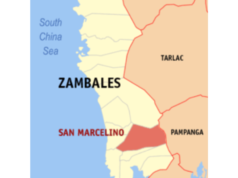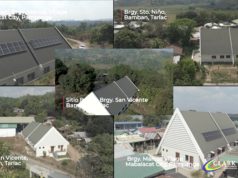In the last few months, thousands of pilgrims have been drawn here. Reason: to visit and venerate the permanently enthroned first degree replica of the “Holy Face of Jesus of Manoppello” in the Catholic church here.
The replica is raising this town from the doldrums and good tidings are fluttering.
“There’s a noticeable spiritual awakening among residents here since last year,” said Fr. Christian Magtalas, parish priest. “Pilgrims elsewhere come here in big numbers every now and then to venerate the replica of the Holy Face of Jesus,” he added.
More pilgrims are expected to come here as the church is looming to be declared as the sanctuary of the relic icon in Asia soon.
This town (population: 13,300; classification: 5th) was earlier called as “Nagpicuan,” a Pangasinense word for “curva” or curved trail to Moncada in Tarlac and Cuyapo in Nueva Ecija. Though it is 180 kilometers north of Manila via the Maharlika Highway, it can now be reached in five minutes from the Anao, Tarlac tollways of the Tarlac-Pangasinan-La Union Expressway (TPLEx).
On September 16 last year, however, it became a straight path for the visit and permanent enthronement of the replica. On that day, Archbishop Florentino Galang Lavarias of San Fernando, Pampanga; Bishops Roberto Mallari of the Diocese of San Jose and Florentino Cinense of Tarlac; Fr. Carmine Cucinelli, rector of the Holy Face Basilica in Manoppello; and Fr. Christian Magtalas, parish priest of the Immaculate Conception Parish here, officiated in the enthronement of the replica.
“It is one of only two first degree replicas of the Holy Face of Manoppello,” Magtalas said.
“The first is at the Manopello basilica for public viewing and veneration while the original is kept in a certain place within the basilica,” he added quoting from sources.
By first degree, he explained, some elements of the original were incorporated in it.
The original relic is described as the “Sudarium,” the piece of cloth or napkin made of sea byssus or a precious marine silk, which covered the face of the dead Jesus in his entombment. Measuring 6.70 inches by 9.45 inches encased between two framed panes of glass, it has an imprint of an effigy “of a longhaired man with broken nose, bloodstained forehead, swollen cheek, half-open mouth, dark brows covering his face, and eyes in an irregular way completely open.”
On it is the imprint of the risen Jesus “with open eyes, swollen left face, and halfopen mouth.” It is placed between two glass panes and encased in a reliquary-like frame and is visible in both the front and back sides.
From the tomb, the Sudarium had a history of being secretly kept somewhere, travelling from one country to another, stolen twice, and was handed by a stranger to a doctor in 1506 in the mountain village of Manoppello and was kept by his family for almost 100 years. It was eventually turned over to the Capuchin monks in that town who until now are the official caretakers of the relics.
Fast forward to 2013. A Filipina staying in the United States of America, Daisy Nieves, a devotee afflicted with a debilitating illness who visited the Manoppello shrine at least ten times, proposed to Fr. Cucinelli to propagate devotion to the relic in America and the Philippines. The priest was granted approval by his archbishop for the tour of the replica in the US and the Philippines starting on September 2, 2014 to return back to Manoppello 12 days later.
It was at this time that a native of this town, Ernest Alzate and wife Lenlen, who are both staying in the USA and became a friend to Nieves, thought of the idea of including this town in the visit of the relic to the Philippines whose original itinerary was Metro Manila.
With the three of them, and Fr. Magtalas, they appealed to the Manoppello church authorities to include this town in the visit of the relic. Magtalas, with the Catholic faithful here, then stormed heaven with their recitation of 4,000 Hail Mary’s on two occasions lasting two hours each to a much more noble intentions.
“It was fate and faith that did it. The replica did not only visit our town but was allowed to stay here permanently,” Magtalas said.




